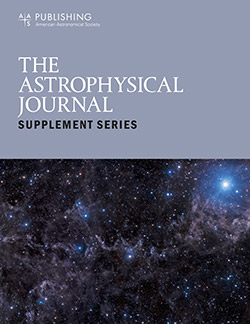Critically Evaluated Atomic Data for the Au iv Spectrum
IF 8.5
1区 物理与天体物理
Q1 ASTRONOMY & ASTROPHYSICS
引用次数: 0
Abstract
Abstract A spectral investigation of triply ionized gold (Au iv ) has been carried out in the wavelength region of 500–2106 Å. The gold spectra were photographed at the National Institute of Standards and Technology, USA, on a 10.7 m normal incidence vacuum spectrograph (NIVS) using a sliding spark source as well as on a 3 m NIVS at the Antigonish laboratory in Canada with a triggered spark source. Our analysis is theoretically supported by the pseudorelativistic Hartree–Fock (HFR) formalism with a superposition of configuration interactions implemented in Cowan's suite of codes. Radiative transition parameters are also calculated using the HFR+CPOL (core polarization effects) model and the multiconfiguration Dirac–Hartree–Fock approach, and their comparisons are used to evaluate the transition rate data. All the previously reported levels of the 5 d 8 , 5 d 7 6 s , and 5 d 7 6 p configurations are confirmed, except one, and three are newly established. The missing 1 S 0 level of 5 d 8 is now established at 55,277.8 cm −1 . A total of 981 observed lines (E1 type), classified to 1031 transitions, including 133 newly identified, enabled us to optimize 139 energy levels. Several astrophysically important transitions, forbidden (M1- and E2-type) lines of 5 d 8 and 5 d 7 6 s , are provided with their Ritz wavelengths and radiative parameters. A critically evaluated set of energy levels, observed and Ritz wavelengths along with their uncertainties, transition rates, and uniformly scaled intensities of Au iv lines have been presented. Also, large-scale atomic data to compute the opacity of Au iv in the kilonova ejecta have been supplemented in this work.对Au iv光谱进行严格评估的原子数据
摘要对三电离金(Au iv)在500-2106 Å波长范围内的光谱进行了研究。金光谱是在美国国家标准与技术研究所的10.7米法向真空光谱仪(NIVS)上使用滑动火花源拍摄的,以及在加拿大安提戈尼什实验室的3米NIVS上使用触发火花源拍摄的。我们的分析在理论上得到了伪相对论Hartree-Fock (HFR)形式主义的支持,该形式主义在Cowan的代码套件中实现了组态相互作用的叠加。利用HFR+CPOL(核心极化效应)模型和多组态Dirac-Hartree-Fock方法计算了辐射跃迁参数,并利用它们的比较来评估跃迁速率数据。除1个外,所有先前报道的5 d 8、5 d 7 6 s和5 d 7 6 p配置水平均得到确认,另外3个是新建立的。5 d 8缺失的1 S 0水平现在建立在55,277.8 cm−1。共有981条观测到的E1型谱线,分为1031个跃迁,其中133个是新发现的,使我们能够优化139个能级。几个重要的天体物理跃迁,禁止(M1和e2型)5 d 8和5 d 7 6 s线,提供了它们的里兹波长和辐射参数。提出了一组经过严格评估的能级、观测波长和里兹波长,以及它们的不确定度、跃迁率和Au iv线的均匀缩放强度。此外,本工作还补充了用于计算千新星喷出物中Au iv不透明度的大规模原子数据。
本文章由计算机程序翻译,如有差异,请以英文原文为准。
求助全文
约1分钟内获得全文
求助全文
来源期刊

Astrophysical Journal Supplement Series
地学天文-天文与天体物理
CiteScore
14.50
自引率
5.70%
发文量
264
审稿时长
2 months
期刊介绍:
The Astrophysical Journal Supplement (ApJS) serves as an open-access journal that publishes significant articles featuring extensive data or calculations in the field of astrophysics. It also facilitates Special Issues, presenting thematically related papers simultaneously in a single volume.
 求助内容:
求助内容: 应助结果提醒方式:
应助结果提醒方式:


